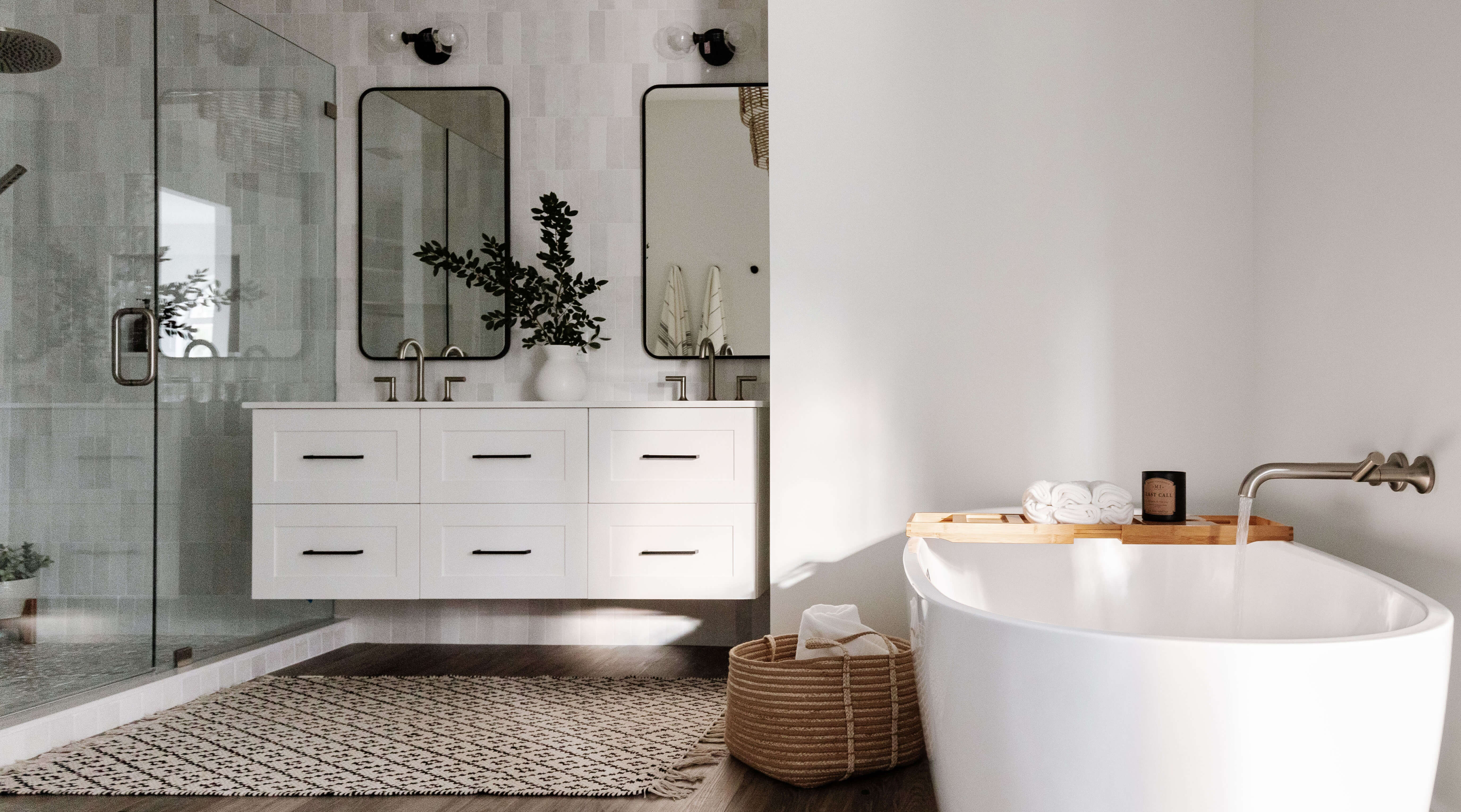Challenges and Considerations

Installing a bathroom vanity over a baseboard heater presents a unique set of challenges and considerations. While it can be a stylish and functional solution, it’s crucial to address potential safety concerns and ensure proper structural support. This approach requires careful planning and attention to detail to ensure a successful and safe installation.
Heat Exposure and Ventilation, Bathroom vanity over baseboard heater
The proximity of the vanity to the heater raises concerns about heat exposure and ventilation. The heat from the heater can potentially damage the vanity’s finish, warp its materials, or even pose a fire hazard if not properly managed.
- Material Selection: Choose heat-resistant materials for the vanity, such as ceramic, stone, or heat-treated wood. Avoid using materials susceptible to warping or damage from heat, like MDF or particleboard.
- Ventilation: Ensure adequate ventilation to dissipate heat and prevent moisture buildup. This might involve installing a vent fan above the vanity or ensuring proper airflow from existing bathroom ventilation.
- Distance: Maintain a safe distance between the heater and the vanity, following manufacturer recommendations and local building codes. This helps prevent direct heat contact and minimizes the risk of damage.
Structural Requirements
Supporting the weight of a bathroom vanity over a baseboard heater requires careful consideration of structural requirements. The heater’s location and the vanity’s weight can impact the necessary support.
- Wall Strength: Assess the wall’s structural integrity to ensure it can support the vanity’s weight. Consult with a structural engineer if necessary to confirm the wall’s load-bearing capacity.
- Anchoring: Use appropriate anchoring methods to securely attach the vanity to the wall, considering the wall material and the vanity’s weight. This ensures stability and prevents the vanity from falling.
- Reinforcement: If the wall is not strong enough to support the vanity, consider reinforcing it with additional framing or structural support beams.
Vanity Size and Style
Selecting the appropriate vanity size and style is crucial to ensure a harmonious fit and functionality, considering the heater’s dimensions and the bathroom’s overall design.
- Dimensions: Measure the space available above the heater, including any obstructions, to determine the maximum vanity width and depth. Ensure the vanity’s dimensions allow for comfortable use and adequate clearance.
- Style: Choose a vanity style that complements the bathroom’s design and complements the heater’s aesthetic. Consider the vanity’s height, leg design, and overall style to create a cohesive look.
- Functionality: Consider the vanity’s storage capacity and functionality to meet your bathroom’s needs. Opt for a vanity with drawers, shelves, or cabinets that provide ample storage space for toiletries and other essentials.
Installation Methods and Techniques

Installing a bathroom vanity over a baseboard heater requires careful planning and execution to ensure both functionality and safety. This process involves selecting the appropriate installation method, securing the vanity to the wall, managing heat flow, and addressing potential challenges.
Methods for Installing a Vanity Over a Baseboard Heater
There are several methods for installing a bathroom vanity over a baseboard heater, each with its own advantages and disadvantages.
- Direct Mounting: This method involves directly attaching the vanity to the wall studs using screws or anchors. It offers a secure and stable installation, but requires careful consideration of the heater’s location and potential heat damage to the vanity.
- Floating Installation: This method involves using brackets or supports to suspend the vanity above the heater, creating a floating appearance. This method minimizes contact with the heater, reducing the risk of heat damage, but requires careful planning to ensure adequate support and stability.
- Heater Shield Installation: This method involves installing a heat shield between the vanity and the heater to protect the vanity from direct heat exposure. The shield can be made of materials like metal or heat-resistant insulation. This method provides excellent protection but adds complexity to the installation process.
Securing the Vanity to the Wall
Securing the vanity to the wall is crucial for stability and safety. The specific method depends on the chosen installation method and the wall material.
- Direct Mounting: For direct mounting, locate wall studs and use appropriate screws or anchors to attach the vanity to the studs. Ensure that the screws are long enough to penetrate the wall material adequately.
- Floating Installation: For floating installations, use brackets or supports that are designed to withstand the weight of the vanity. Secure the brackets or supports to the wall studs or use heavy-duty anchors for concrete or brick walls.
- Heater Shield Installation: For heater shield installations, attach the shield to the wall using screws or anchors, ensuring it covers the heater completely. Then, secure the vanity to the shield using appropriate screws or anchors.
Managing Heat Flow
Managing the flow of heat from the baseboard heater is essential to prevent damage to the vanity and ensure safe operation.
- Ventilation: Ensure adequate ventilation around the heater to allow heat to circulate freely. This can be achieved by leaving a gap between the vanity and the wall or by installing a vent in the back of the vanity.
- Heat Shield: Consider using a heat shield to deflect heat away from the vanity. The shield should be made of a material that can withstand high temperatures and be properly installed to prevent heat buildup.
- Heat-Resistant Materials: Select a vanity made of heat-resistant materials like stone, ceramic, or metal to minimize the risk of damage from the heater.
Step-by-Step Guide for Installing a Vanity Over a Baseboard Heater
This step-by-step guide provides a comprehensive overview of the installation process.
- Plan and Measure: Determine the desired vanity location, taking into account the heater’s size and position. Measure the space carefully to ensure the vanity fits correctly and allows for adequate ventilation.
- Select Installation Method: Choose the appropriate installation method based on the vanity’s design, the heater’s location, and your desired aesthetic.
- Prepare the Wall: Clear the wall area of any obstacles or debris. If necessary, repair any damaged sections of the wall.
- Install Heater Shield (Optional): If using a heat shield, install it according to the manufacturer’s instructions, ensuring it covers the heater completely.
- Attach Vanity to Wall: Secure the vanity to the wall using the chosen method, ensuring it is level and stable.
- Install Sink and Faucet: Install the sink and faucet according to the manufacturer’s instructions.
- Connect Plumbing: Connect the water supply lines and drain pipe to the vanity.
- Test for Leaks: Turn on the water supply and check for any leaks.
- Finish Installation: Install the vanity top, doors, and hardware according to the manufacturer’s instructions.
Essential Tools and Materials
- Level
- Measuring Tape
- Screwdriver
- Drill
- Screws or Anchors
- Brackets or Supports (for floating installations)
- Heat Shield (optional)
- Caulk
- Plumbing Supplies
- Safety Glasses
- Work Gloves
Alternative Solutions and Workarounds: Bathroom Vanity Over Baseboard Heater

The presence of a baseboard heater in a bathroom can indeed pose a challenge when installing a vanity. However, with some ingenuity and planning, you can create a functional and aesthetically pleasing space. This section explores alternative solutions and workarounds to accommodate both the vanity and the heater, ensuring your bathroom is both stylish and comfortable.
Modifying the Heater
Modifying the heater can be a viable option to optimize space utilization. This approach involves adjusting the heater’s dimensions or configuration to accommodate the vanity.
- Shortening the Heater: If the heater is excessively long, shortening it can create space for the vanity. However, this should be done by a qualified professional to ensure proper functioning and safety.
- Relocating the Heater: Moving the heater slightly can allow for a more strategic placement of the vanity. This might involve shifting the heater to a different wall or adjusting its position within the existing wall.
- Utilizing a Smaller Heater: If the existing heater is too bulky, consider replacing it with a smaller, more compact model. This can significantly free up space for the vanity.
Modifying the Vanity
Modifying the vanity can also be a solution to accommodate the heater. This involves adjusting the vanity’s dimensions or design to fit the existing space.
- Creating a Custom Vanity: A custom-designed vanity can be tailored to fit the available space, incorporating the heater’s dimensions. This provides a perfect fit and a unique look.
- Utilizing a Narrower Vanity: Choosing a narrower vanity can create space for the heater, while still providing adequate storage and functionality.
- Using a Floating Vanity: A floating vanity can be installed above the heater, maximizing floor space and minimizing the impact on the heater’s functionality.
Relocating the Heater
Relocating the heater to a different location within the bathroom can be a more drastic solution but may be necessary in some cases.
- Moving the Heater to a Different Wall: If possible, relocating the heater to a different wall can free up space for the vanity. This requires careful planning and professional installation to ensure proper ventilation and safety.
- Installing a New Heater in a Different Location: If relocating the existing heater is not feasible, consider installing a new heater in a different location, such as above the door or on an adjacent wall.
Utilizing a Different Heating System
In some situations, replacing the baseboard heater with a different type of heating system can be a viable option.
- Installing a Wall-Mounted Heater: A wall-mounted heater can be installed higher on the wall, freeing up floor space for the vanity.
- Utilizing a Towel Warmer: A towel warmer can be integrated into the vanity design, providing both heat and storage.
- Implementing a Radiant Floor Heating System: A radiant floor heating system can provide warmth without the need for a baseboard heater, freeing up space for the vanity.
